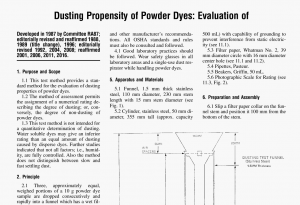Dusting Propensity of Powder Dyes

AATCC 170-2016 pdf free.Dusting Propensity of Powder Dyes: Evaluation of.
2.1 Three, approximately equal,weighed portions of a 10 g powder dyesample are dropped consecutively andrapidly into a funnel which has a wet filter paper collar on the stem and is fittedinto a cylinder. Any dust which formsrises and settles on the prewet filter paper collar.
2.2 The resulting coloration on the filter paper is then compared to a series offive standards and a numerical rating isassigned.
3.Terminology
3.1 dusting, n.—the tendency of particles of sufficiently low mass to becomeairborne when a powder material is handled or agitated.
3.2 dye,n.—a colorant applied to orformed in a substrate, via the molecularydispersed state,which exhibits some degree of permanence.
4. Safety Precautions
NOTE: These safety precautions arefor information purposes only.The precautions are ancillary to the testing procedures and are not intended to be all inclusive.It is the user’s responsibility to usesafe and proper techniques in handlingmaterials in this test method. Manufacturers MUST be consulted for specificdetails such as material safety data sheets and other manufacturer’s recommenda-tions. All OSHA standards and rulesmust also be consulted and followed.4.1 Good laboratory practices shouldbe followed. Wear safety glasses in alllaboratory areas and a single-use dust respirator while handling powder dyes.5. Apparatus and Materials
5.1 Funnel,1.5 mm thick stainlesssteel,110 mm diameter,230 mm stemlength with 15 mm stem diameter (seeFig.1).
5.2 Cylinder, stainless steel, 50 mm diameter,355 mm tall (approx. capacity 500 mL) with capability of grounding toprevent interference from static electricity (see 11.1).
5.3 Filter paper,Whatman No.2,39mm diameter circle with 16 mm diametercenter hole (see 11.1 and 11.2).
5.4 Pipettes, Pasteur.
5.5 Beakers, Griffin,50 mL.
5.6 Photographic Scale for Rating (see11.3, Fig. 2).
6. Preparation and Assembly
6.1 Slip a filter paper collar on the fun-nel stem and position it 100 mm from thebottom of the stem.
6.2 Moisten the paper collar with threedrops of distilled water at points approximately equidistant from one anotheraround the stem of the funnel.Use care toavoid water running down the funnelstem.
6.3 Place the funnel, with wet collar, inthe steel cylinder. Ground the cylinder(see 11.4). The paper collar should be200 mm from the bottom of the steelcylinder.
7.Procedure
7.1 Use a 10 g sample of powder dye,weighing it out as 3.3 g portions,intothree 50 mL beakers.
7.2 Pour the three portions of dye ontothe side of the funnel at intervals of approximately 2-3 s.
7.3 Allow the apparatus to remain undisturbed for 3 min to avoid erroneous results due to any external effects on the airin the cylinder.
7.4 Remove the funnel and, with scissors, snip off the filter paper collar fromits periphery to the stem for easy removal(see 11.5). Air dry the collar by placing it on a sheet of filter paper away frompossible sources of atmospheric”fly”orcontaminants.
8. Evaluation
8.1 Compare the specimen with thescale (see 11.3) and assign the appropriate numerical rating. Intermediate ratings; e.g., 4-5 may be estimated.
8.2 The matching standard establishesa numerical rating for degree of dusting.A rating of 1 describes a very dusty mate-rial and a rating of 5 describes a nondusting or minimally dusting dye.
8.3 Duplicate or triplicate tests may beconducted and the average noted.
9. Report
9.1 Report the numerical rating for degree of dusting.
10.Precision and Bias
10.1 Precision. Precision for this testmethod has not been established. Until aprecision statement is generated for this method, use standard statistical techniquesin making any comparisons of test resultsfor either within-laboratory or between-laboratory averages.
10.2 Bias. Dusting propensity can onlybe defined in terms of a test method.There is no independent method for de-termining the true value. As a means ofestimating this property, the method hasno known bias.
11. Notes
11.1 Stainless steel funnels,cylinders,andfilter paper collars are available from AATCC,PO.Box 12215, Research Triangle Park NC27709;tel: +1.919.549.8141; fax: +1.919.549.8933;e-mail: orders@aatcc.org; web site:www.aatcc.org.
11.2 Filter paper collars required for thistest may be prepared in a number of differentways.
i1.2.1 Larger circles of paper may be diecut or hand cut to size with scissors and thecenter hole punched out with a light blow on a#6 cork borer.
11.3 The illustration of the dusting scale inthe text of this method is inadequate for theevaluation. A standard scale (photographicreplicas) must be used and is available fromAATCC,P.O.Box 12215,Research TrianglePark NC27709; tel:+1.919.549.8141; fax: +1.919.549.8933;email: orders@aatcc.org; website: www.aatcc.org.
11.4 The steel cylinder is grounded by con-necting one end of a copper conductor (No.14solid wire) to the grounding screw at the baseof the cylinder and the other end clamped to ametallic (not plastic) water pipe or any metallic electrical conduit.
11.5 Pulling the paper collar off the stem ofthe funnel without using the scissors causes a“squeegee”effect which could lead to erroneous results.AATCC 170 pdf download.

Dusting Propensity of Powder Dyes